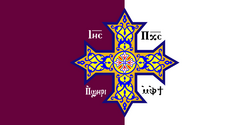User:Bigmoney/Sandbox: Difference between revisions
mNo edit summary |
|||
| Line 10: | Line 10: | ||
| orientation = [[wikipedia:Miaphysitism|Miaphysitism]] | | orientation = [[wikipedia:Miaphysitism|Miaphysitism]] | ||
| theology = | | theology = | ||
| polity = {{wp| | | polity = {{wp|Presbyterian_polity|Presbyterian}} | ||
| governance = | | governance = | ||
| structure = | | structure = | ||
| Line 23: | Line 23: | ||
| members = 18 million (official records) | | members = 18 million (official records) | ||
}} | }} | ||
The '''Tyreseian Coptic Church''' or '''Nazarene Copts''', officially the '''Most Holy Coptic Church of the Nazarenes''' or simply '''Coptic Nazarism''' is a {{wp|Christianity|Sarpetic religion}}, operating as a distant offshoot of the [[Alban_Nazarism|Alban church]]. The faith is named after the now-abandoned Hellenic settlement of Kóptos; this town is taught by Church tradition to be its birthplace following the arrival of Saint Euphrosynos of Adrianople. Working from a {{wp|Gnosticism|Gnostic}} interpretation of the {{wp|Bible|Two Treasures}}, Euphrosynos preached a wholly dualistic vision of Yeshua and of the Godhead that quickly took root in the communities of modern-day Tyreseia and other fringes of the Alban world. Diverging from St. Alban's vision of a purely monastic polity, Euphrosynos created a largely | The '''Tyreseian Coptic Church''' or '''Nazarene Copts''', officially the '''Most Holy Coptic Church of the Nazarenes''' or simply '''Coptic Nazarism''' is a {{wp|Christianity|Sarpetic religion}}, operating as a distant offshoot of the [[Alban_Nazarism|Alban church]]. The faith is named after the now-abandoned Hellenic settlement of Kóptos; this town is taught by Church tradition to be its birthplace following the arrival of Saint Euphrosynos of Adrianople. Working from a {{wp|Gnosticism|Gnostic}} interpretation of the {{wp|Bible|Two Treasures}}, Euphrosynos preached a wholly dualistic vision of Yeshua and of the Godhead that quickly took root in the communities of modern-day Tyreseia and other fringes of the Alban world. Diverging from St. Alban's vision of a purely monastic polity, Euphrosynos created a largely presbyterian structure that survives nearly unchanged to this day. | ||
Still a largely Gnostic faith, the Coptic Church adopted elements of [[wikipedia:Esoteric_Christianity|esoterism]] and [[wikipedia:Christian_mysticism|mysticism]] over the centuries as part of a central belief that active pursuit of knowledge, especially through invention and exploration of the cosmos, brings the faithful closer to the Unbegotten and hastens the onset of the End Times. | Still a largely Gnostic faith, the Coptic Church adopted elements of [[wikipedia:Esoteric_Christianity|esoterism]] and [[wikipedia:Christian_mysticism|mysticism]] over the centuries as part of a central belief that active pursuit of knowledge, especially through invention and exploration of the cosmos, brings the faithful closer to the Unbegotten and hastens the onset of the End Times. Despite this, Coptic monastic orders and societies exist, though they are not as numerous or as prominent as they were in their heyday. | ||
At present, the vast majority of Copts live in [[Tyreseia]], though smaller communities exist across the [[Periclean_world|Periclean basin]] and elsewhere. | At present, the vast majority of Copts live in [[Tyreseia]], though smaller communities exist across the [[Periclean_world|Periclean basin]] and elsewhere. | ||
| Line 32: | Line 32: | ||
==History== | ==History== | ||
Founding stuff | |||
By the time of the Xth century, the Coptic Church had solidified its position in a post-Latin Periclean region, with the Presbyter Princeps establishing a primary see in the city of Tyria while the Rector Princeps established administrative headquarters in the city of Gadir. With the collapse of the hostile, Fabrian Catholic-leaning Latin Empire, the Coptic Church was suddenly free to grow and expand. | |||
==Organization== | ==Organization== | ||
==Interfaith Relations== | ==Interfaith Relations== | ||
Revision as of 01:44, 25 September 2021
Tyreseian Coptic Church
The Most Holy Coptic Church of the Nazarenes | |
|---|---|
 | |
| Classification | Non-Nicaean |
| Orientation | Miaphysitism |
| Polity | Presbyterian |
| Leaders | Presbyter Princeps Zephyrinus Victor I Rector Princeps Paul XXIII |
| Founder | Saint Paul (traditional) Saint Alban of Vigueria (traditional) Saint Euphrosynos of Adrianople |
| Origin | 1st century Tyreseia |
| Members | 18 million (official records) |
The Tyreseian Coptic Church or Nazarene Copts, officially the Most Holy Coptic Church of the Nazarenes or simply Coptic Nazarism is a Sarpetic religion, operating as a distant offshoot of the Alban church. The faith is named after the now-abandoned Hellenic settlement of Kóptos; this town is taught by Church tradition to be its birthplace following the arrival of Saint Euphrosynos of Adrianople. Working from a Gnostic interpretation of the Two Treasures, Euphrosynos preached a wholly dualistic vision of Yeshua and of the Godhead that quickly took root in the communities of modern-day Tyreseia and other fringes of the Alban world. Diverging from St. Alban's vision of a purely monastic polity, Euphrosynos created a largely presbyterian structure that survives nearly unchanged to this day.
Still a largely Gnostic faith, the Coptic Church adopted elements of esoterism and mysticism over the centuries as part of a central belief that active pursuit of knowledge, especially through invention and exploration of the cosmos, brings the faithful closer to the Unbegotten and hastens the onset of the End Times. Despite this, Coptic monastic orders and societies exist, though they are not as numerous or as prominent as they were in their heyday.
At present, the vast majority of Copts live in Tyreseia, though smaller communities exist across the Periclean basin and elsewhere.
Principal Beliefs
History
Founding stuff
By the time of the Xth century, the Coptic Church had solidified its position in a post-Latin Periclean region, with the Presbyter Princeps establishing a primary see in the city of Tyria while the Rector Princeps established administrative headquarters in the city of Gadir. With the collapse of the hostile, Fabrian Catholic-leaning Latin Empire, the Coptic Church was suddenly free to grow and expand.